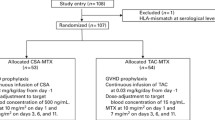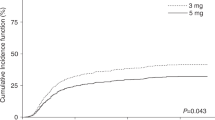Abstract
Combination of calcineurin inhibitors (CIs) with short-term methotrexate is a standard prophylactic regimen for graft-versus-host disease (GVHD). However, it is sometimes difficult to continue CIs due to adverse effects, such as renal impairment and fluid overload. In such cases, we replace CIs with corticosteroids, considering that full dose of CIs is equivalent to prednisolone (PSL) at 1 mg/kg. We retrospectively evaluated the clinical significance of replacement of CIs with corticosteroids after allogeneic hematopoietic cell transplantation (HCT). We evaluated 42 patients switched from CIs to corticosteroids within 90 days among the 479 patients who underwent allogeneic HCT at our center between 2007 and 2019. Renal impairment (n = 33), fluid overload (n = 13), and thrombotic microangiopathy (n = 3) were the main reasons for switching. Although creatinine and body weight returned to baseline at 4 weeks after switching, 100-day non-relapse mortality was high (57.1%). Grade II–IV acute GVHD was seen in 10 (24.4%) patients who did not have it before switching treatment (n = 41). In conclusion, CIs were switched to corticosteroids in patients with severe clinical conditions. The incidence of acute GVHD was acceptable. Although the short-term mortality rate was high, improvement of renal function or fluid overload was observed in a certain proportion of the patients.



Similar content being viewed by others
Data availability
All data generated or analyzed during this study are included in this article. Further enquiries can be directed to the corresponding author.
References
Wiederrecht G, Lam E, Hung S, Martin M, Sigal N. The mechanism of action of FK-506 and cyclosporin A. Ann NY Acad Sci. 1993;696:9–19.
Schreiber SL, Crabtree GR. The mechanism of action of cyclosporin A and FK506. Immunol Today. 1992;13:136–42.
Kahan BD. Cyclosporine. N Engl J Med. 1989;321:1725–38.
Klintmalm GB. FK 506: an update. Clin Transpl. 1994;8:207–10.
Ishida Y, Matsuda H, Kida K. Effect of cyclosporin a on human bone marrow granulocyte-macrophage progenitors with anti-cancer agents. Acta Paediatr Jpn. 1995;37:610–3.
Kanda Y. Investigation of the freely available easy-to-use software “EZR” for medical statistics. Bone Marrow Transpl. 2013;48:452–8.
Kanda Y, Kobayashi T, Mori T, Tanaka M, Nakaseko C, Yokota A, et al. A randomized controlled trial of cyclosporine and tacrolimus with strict control of blood concentrations after unrelated bone marrow transplantation. Bone Marrow Transpl. 2016;51:103–9.
Myers BD, Ross J, Newton L, Luetscher J, Perlroth M. Cyclosporine-associated chronic nephropathy. N Engl J Med. 1984;311:699–705.
Calne RY, White DJ, Thiru S, Evans DB, McMaster P, Dunn DC, et al. Cyclosporin A in patients receiving renal allografts from cadaver donors. Lancet. 1978;2:1323–7.
Calne RY, Rolles K, White DJ, Thiru S, Evans DB, McMaster P, et al. Cyclosporin A initially as the only immunosuppressant in 34 recipients of cadaveric organs: 32 kidneys, 2 pancreases, and 2 livers. Lancet. 1979;2:1033–6.
Naesens M, Kuypers DRJ, Sarwal M. Calcineurin inhibitor nephrotoxicity. Clin J Am Soc Nephrol. 2009;4:481–508.
Lanese DM, Conger JD. Effects of endothelin receptor antagonist on cyclosporine-induced vasoconstriction in isolated rat renal arterioles. J Clin Invest. 1993;91:2144–9.
De Nicola L, Thomson SC, Wead LM, Brown MR, Gabbai FB. Arginine feeding modifies cyclosporine nephrotoxicity in rats. J Clin Invest. 1993;92:1859–65.
Ruggenenti P, Perico N, Mosconi L, Gaspari F, Benigni A, Amuchastegui CS, et al. Calcium channel blockers protect transplant patients from cyclosporine-induced daily renal hypoperfusion. Kidney Int. 1993;43:706–11.
Lamas S. Cellular mechanisms of vascular injury mediated by calcineurin inhibitors. Kidney Int. 2005;68:898–907.
Scherrer U, Vissing SF, Morgan BJ, Rollins JA, Tindall RS, Ring S, et al. Cyclosporine-induced sympathetic activation and hypertension after heart transplantation. N Engl J Med. 1990;323:693–9.
Higgins R, Ramaiyan K, Dasgupta T, Kanji H, Fletcher S, Lam F, et al. Hyponatraemia and hyperkalaemia are more frequent in renal transplant recipients treated with tacrolimus than with cyclosporin. Further evidence for differences between cyclosporin and tacrolimus nephrotoxicities. Nephrol Dial Transpl. 2004;19:444–50.
Tainio J. Calcineurin inhibitor-associated electrolyte disturbances after pediatric renal transplantation: Could fludrocortisone therapy have a role? [Internet]. Pediatr Transpl. 2018. https://doi.org/10.1111/petr.13097.
Dawwas MF, Lewsey JD, Neuberger JM, Gimson AE. The impact of serum sodium concentration on mortality after liver transplantation: a cohort multicenter study. Liver Transpl. 2007;13:1115–24.
Jagasia M, Arora M, Flowers MED, Chao NJ, McCarthy PL, Cutler CS, et al. Risk factors for acute GVHD and survival after hematopoietic cell transplantation. Blood. 2012;119:296–307.
Omer AK, Ziakas PD, Anagnostou T, Coughlin E, Kourkoumpetis T, McAfee SL, et al. Risk factors for invasive fungal disease after allogeneic hematopoietic stem cell transplantation: a single center experience. Biol Blood Marrow Transpl. 2013;19:1190–6.
Ho VT, Cutler C, Carter S, Martin P, Adams R, Horowitz M, et al. Blood and marrow transplant clinical trials network toxicity committee consensus summary: thrombotic microangiopathy after hematopoietic stem cell transplantation. Biol Blood Marrow Transpl. 2005;11:571–5.
Kikuchi M, Akahoshi Y, Nakano H, Ugai T, Wada H, Yamasaki R, et al. Risk factors for pre- and post-engraftment bloodstream infections after allogeneic hematopoietic stem cell transplantation. Transpl Infect Dis. 2015;17:56–65.
Zhao Y, Shi J, Luo Y, Gao F, Tan Y, Lai X, et al. calcineurin inhibitors replacement by Ruxolitinib as graft-versus-host disease prophylaxis for patients after allogeneic stem cell transplantation. Biol Blood Marrow Transpl. 2020;26:e128–33.
Acknowledgements
The authors thank the staff of the Hematology ward, Jichi Medical University Saitama Medical Center, for their contribution to daily clinical practice in hematopoietic stem cell transplantation.
Funding
None to declare.
Author information
Authors and Affiliations
Contributions
SM, S-IK, and YK participated in research design, data analysis and the writing of the paper. YN, MK, JT, SK, NY, YM, KY, AG, YO, YA, MT, MK, KK, HW, AT, MS, HN, and SK participated in the performance of research. AT was in charge of accounting management. All authors revised the manuscript and approved the final version to be submitted.
Corresponding author
Ethics declarations
Conflict of interest
The authors declare that they have no conflict of interest.
Ethical approval
This study was approved by the Institutional Review Board of Jichi Medical University Saitama Medical Center (Saitama, Japan). All procedures performed in studies involving human participants were in accordance with the ethical standards of the institutional and/or national research committee and with the 1964 Helsinki declaration and its later amendments or comparable ethical standards.
Consent to participate
According to the Japanese ethics guideline of clinical studies, we provided information of this retrospective study on the website and enabled patients to be excluded from the study if they do not agree to use their data.
Consent to publish
According to the Japanese ethics guideline of clinical studies, we provided information of this retrospective study on the website and enabled patients to be excluded from the study if they do not agree to use their data.
Additional information
Publisher's Note
Springer Nature remains neutral with regard to jurisdictional claims in published maps and institutional affiliations.
About this article
Cite this article
Matsumi, S., Kimura, Si., Nakamura, Y. et al. Substitution of calcineurin inhibitors with corticosteroids after allogeneic hematopoietic cell transplantation. Int J Hematol 118, 450–461 (2023). https://doi.org/10.1007/s12185-023-03645-4
Received:
Revised:
Accepted:
Published:
Issue Date:
DOI: https://doi.org/10.1007/s12185-023-03645-4




